key battery CHEVROLET HHR 2007 1.G Owners Manual
[x] Cancel search | Manufacturer: CHEVROLET, Model Year: 2007, Model line: HHR, Model: CHEVROLET HHR 2007 1.GPages: 446, PDF Size: 2.43 MB
Page 97 of 446
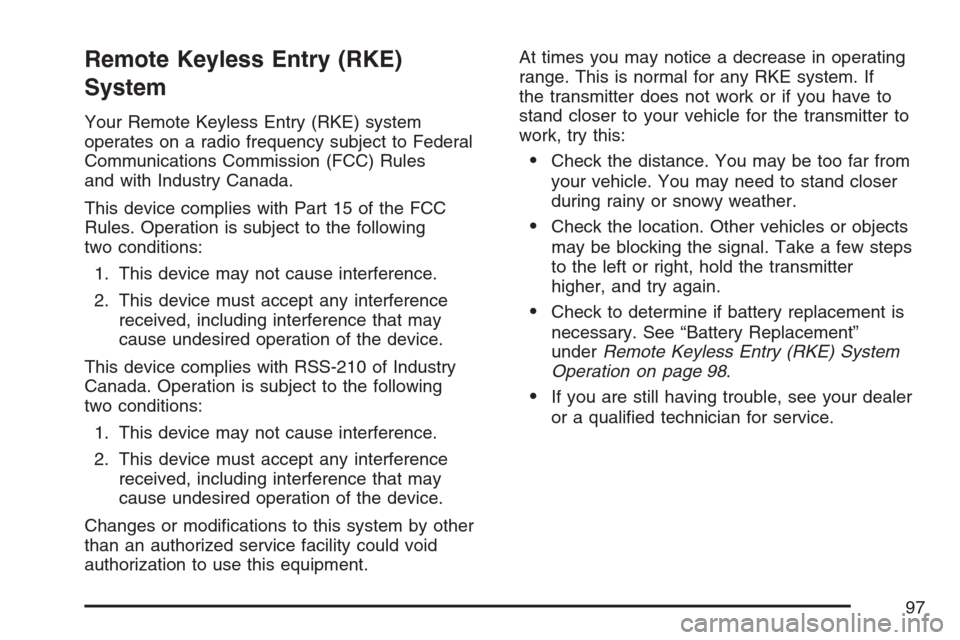
Remote Keyless Entry (RKE)
System
Your Remote Keyless Entry (RKE) system
operates on a radio frequency subject to Federal
Communications Commission (FCC) Rules
and with Industry Canada.
This device complies with Part 15 of the FCC
Rules. Operation is subject to the following
two conditions:
1. This device may not cause interference.
2. This device must accept any interference
received, including interference that may
cause undesired operation of the device.
This device complies with RSS-210 of Industry
Canada. Operation is subject to the following
two conditions:
1. This device may not cause interference.
2. This device must accept any interference
received, including interference that may
cause undesired operation of the device.
Changes or modi�cations to this system by other
than an authorized service facility could void
authorization to use this equipment.At times you may notice a decrease in operating
range. This is normal for any RKE system. If
the transmitter does not work or if you have to
stand closer to your vehicle for the transmitter to
work, try this:
Check the distance. You may be too far from
your vehicle. You may need to stand closer
during rainy or snowy weather.
Check the location. Other vehicles or objects
may be blocking the signal. Take a few steps
to the left or right, hold the transmitter
higher, and try again.
Check to determine if battery replacement is
necessary. See “Battery Replacement”
underRemote Keyless Entry (RKE) System
Operation on page 98.
If you are still having trouble, see your dealer
or a quali�ed technician for service.
97
Page 100 of 446
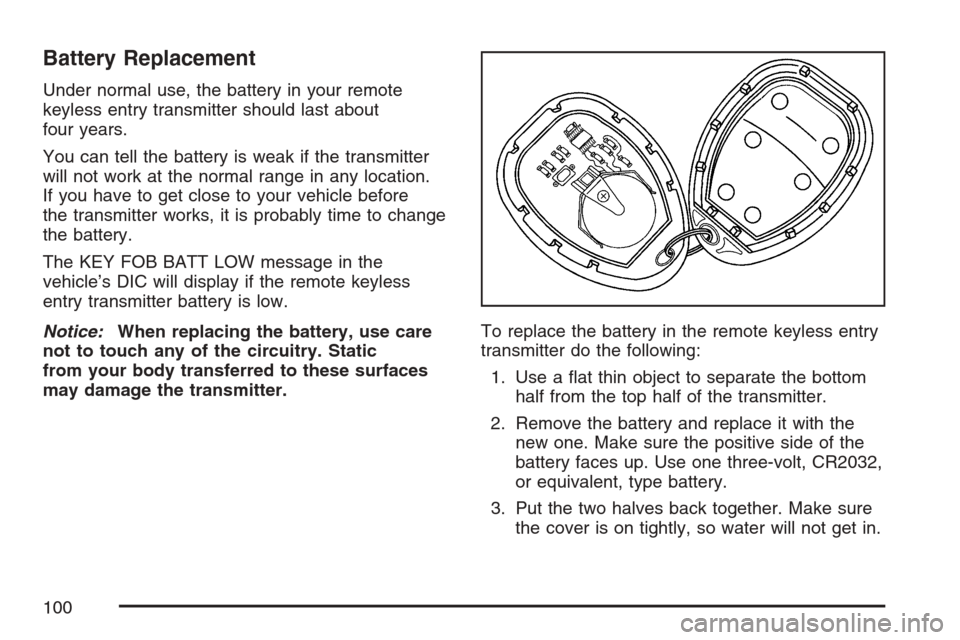
Battery Replacement
Under normal use, the battery in your remote
keyless entry transmitter should last about
four years.
You can tell the battery is weak if the transmitter
will not work at the normal range in any location.
If you have to get close to your vehicle before
the transmitter works, it is probably time to change
the battery.
The KEY FOB BATT LOW message in the
vehicle’s DIC will display if the remote keyless
entry transmitter battery is low.
Notice:When replacing the battery, use care
not to touch any of the circuitry. Static
from your body transferred to these surfaces
may damage the transmitter.To replace the battery in the remote keyless entry
transmitter do the following:
1. Use a �at thin object to separate the bottom
half from the top half of the transmitter.
2. Remove the battery and replace it with the
new one. Make sure the positive side of the
battery faces up. Use one three-volt, CR2032,
or equivalent, type battery.
3. Put the two halves back together. Make sure
the cover is on tightly, so water will not get in.
100
Page 117 of 446
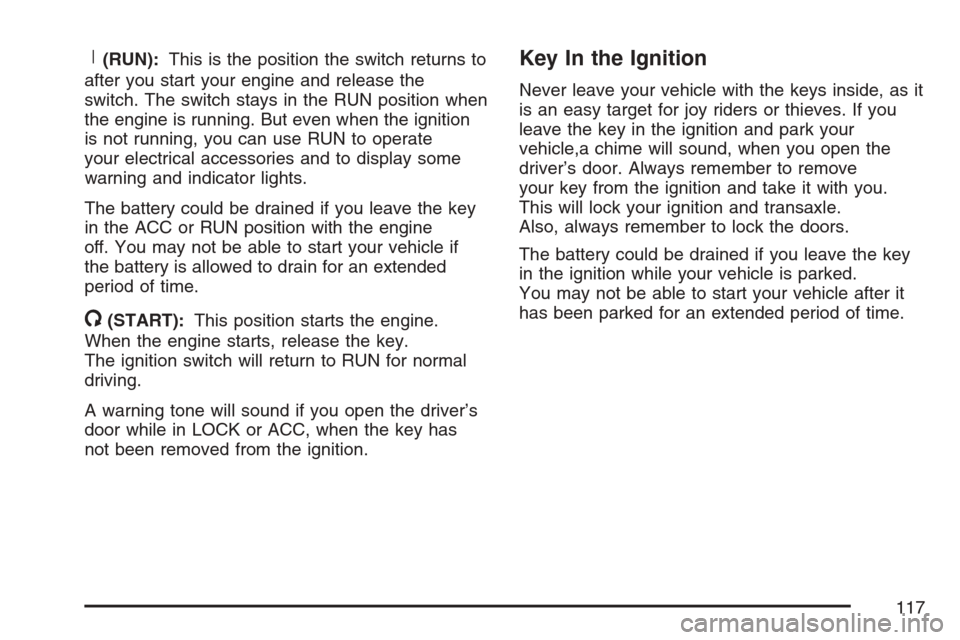
R(RUN):This is the position the switch returns to
after you start your engine and release the
switch. The switch stays in the RUN position when
the engine is running. But even when the ignition
is not running, you can use RUN to operate
your electrical accessories and to display some
warning and indicator lights.
The battery could be drained if you leave the key
in the ACC or RUN position with the engine
off. You may not be able to start your vehicle if
the battery is allowed to drain for an extended
period of time.
/(START):This position starts the engine.
When the engine starts, release the key.
The ignition switch will return to RUN for normal
driving.
A warning tone will sound if you open the driver’s
door while in LOCK or ACC, when the key has
not been removed from the ignition.
Key In the Ignition
Never leave your vehicle with the keys inside, as it
is an easy target for joy riders or thieves. If you
leave the key in the ignition and park your
vehicle,a chime will sound, when you open the
driver’s door. Always remember to remove
your key from the ignition and take it with you.
This will lock your ignition and transaxle.
Also, always remember to lock the doors.
The battery could be drained if you leave the key
in the ignition while your vehicle is parked.
You may not be able to start your vehicle after it
has been parked for an extended period of time.
117
Page 118 of 446
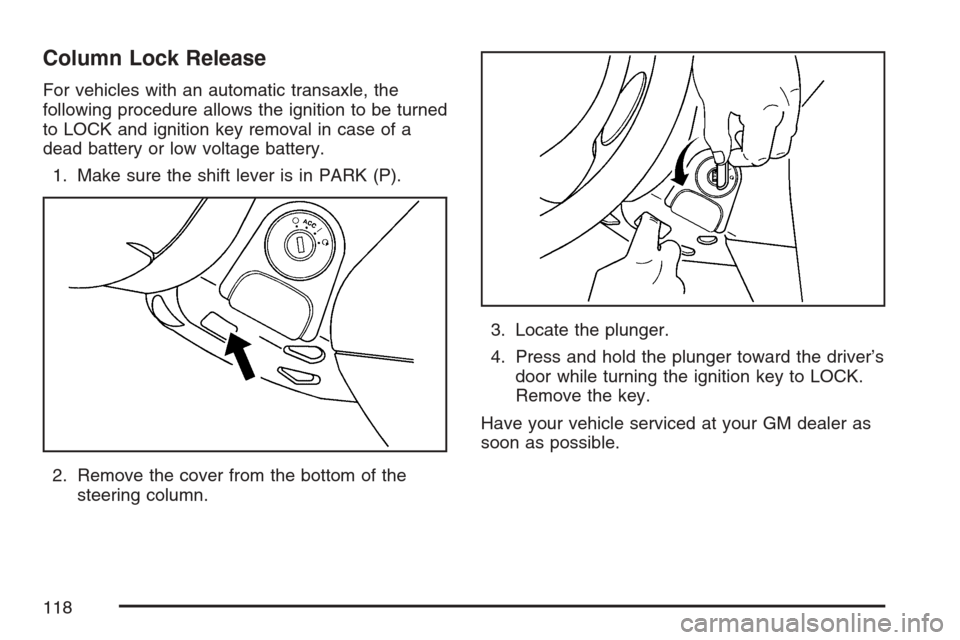
Column Lock Release
For vehicles with an automatic transaxle, the
following procedure allows the ignition to be turned
to LOCK and ignition key removal in case of a
dead battery or low voltage battery.
1. Make sure the shift lever is in PARK (P).
2. Remove the cover from the bottom of the
steering column.3. Locate the plunger.
4. Press and hold the plunger toward the driver’s
door while turning the ignition key to LOCK.
Remove the key.
Have your vehicle serviced at your GM dealer as
soon as possible.
118
Page 120 of 446
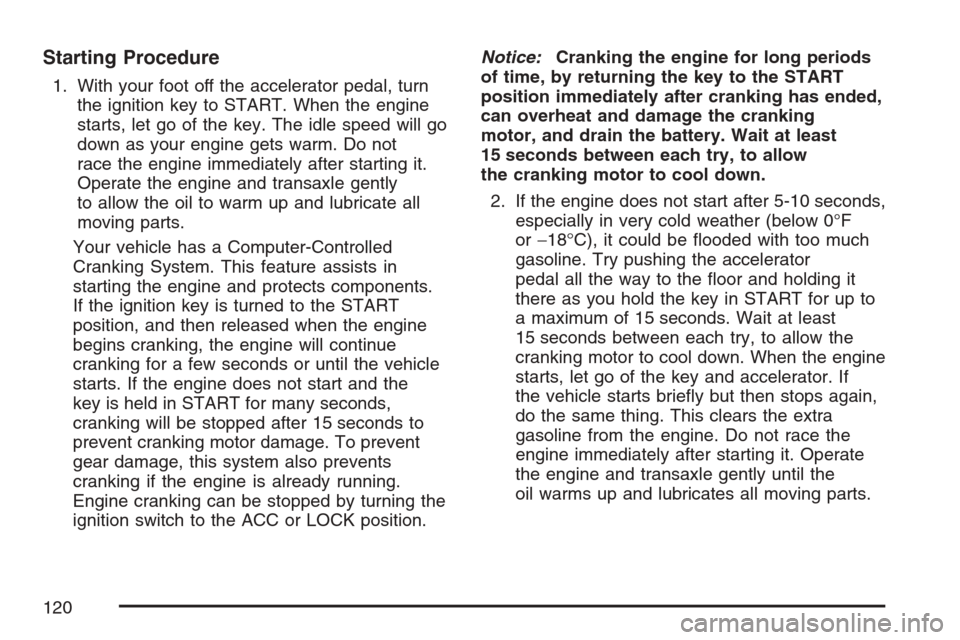
Starting Procedure
1. With your foot off the accelerator pedal, turn
the ignition key to START. When the engine
starts, let go of the key. The idle speed will go
down as your engine gets warm. Do not
race the engine immediately after starting it.
Operate the engine and transaxle gently
to allow the oil to warm up and lubricate all
moving parts.
Your vehicle has a Computer-Controlled
Cranking System. This feature assists in
starting the engine and protects components.
If the ignition key is turned to the START
position, and then released when the engine
begins cranking, the engine will continue
cranking for a few seconds or until the vehicle
starts. If the engine does not start and the
key is held in START for many seconds,
cranking will be stopped after 15 seconds to
prevent cranking motor damage. To prevent
gear damage, this system also prevents
cranking if the engine is already running.
Engine cranking can be stopped by turning the
ignition switch to the ACC or LOCK position.Notice:Cranking the engine for long periods
of time, by returning the key to the START
position immediately after cranking has ended,
can overheat and damage the cranking
motor, and drain the battery. Wait at least
15 seconds between each try, to allow
the cranking motor to cool down.
2. If the engine does not start after 5-10 seconds,
especially in very cold weather (below 0°F
or−18°C), it could be �ooded with too much
gasoline. Try pushing the accelerator
pedal all the way to the �oor and holding it
there as you hold the key in START for up to
a maximum of 15 seconds. Wait at least
15 seconds between each try, to allow the
cranking motor to cool down. When the engine
starts, let go of the key and accelerator. If
the vehicle starts brie�y but then stops again,
do the same thing. This clears the extra
gasoline from the engine. Do not race the
engine immediately after starting it. Operate
the engine and transaxle gently until the
oil warms up and lubricates all moving parts.
120
Page 130 of 446
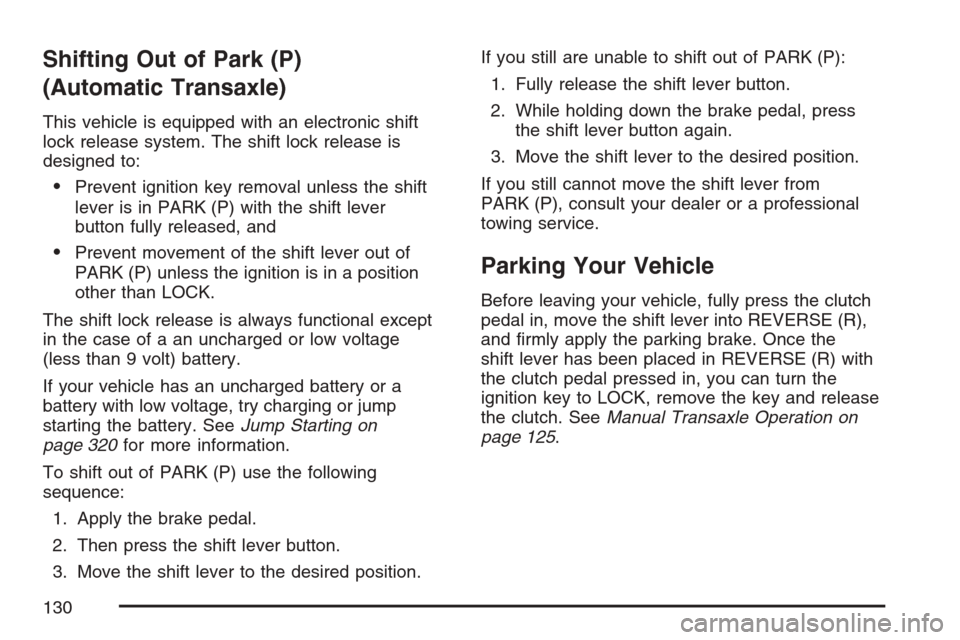
Shifting Out of Park (P)
(Automatic Transaxle)
This vehicle is equipped with an electronic shift
lock release system. The shift lock release is
designed to:
Prevent ignition key removal unless the shift
lever is in PARK (P) with the shift lever
button fully released, and
Prevent movement of the shift lever out of
PARK (P) unless the ignition is in a position
other than LOCK.
The shift lock release is always functional except
in the case of a an uncharged or low voltage
(less than 9 volt) battery.
If your vehicle has an uncharged battery or a
battery with low voltage, try charging or jump
starting the battery. SeeJump Starting on
page 320for more information.
To shift out of PARK (P) use the following
sequence:
1. Apply the brake pedal.
2. Then press the shift lever button.
3. Move the shift lever to the desired position.If you still are unable to shift out of PARK (P):
1. Fully release the shift lever button.
2. While holding down the brake pedal, press
the shift lever button again.
3. Move the shift lever to the desired position.
If you still cannot move the shift lever from
PARK (P), consult your dealer or a professional
towing service.Parking Your Vehicle
Before leaving your vehicle, fully press the clutch
pedal in, move the shift lever into REVERSE (R),
and �rmly apply the parking brake. Once the
shift lever has been placed in REVERSE (R) with
the clutch pedal pressed in, you can turn the
ignition key to LOCK, remove the key and release
the clutch. SeeManual Transaxle Operation on
page 125.
130
Page 199 of 446
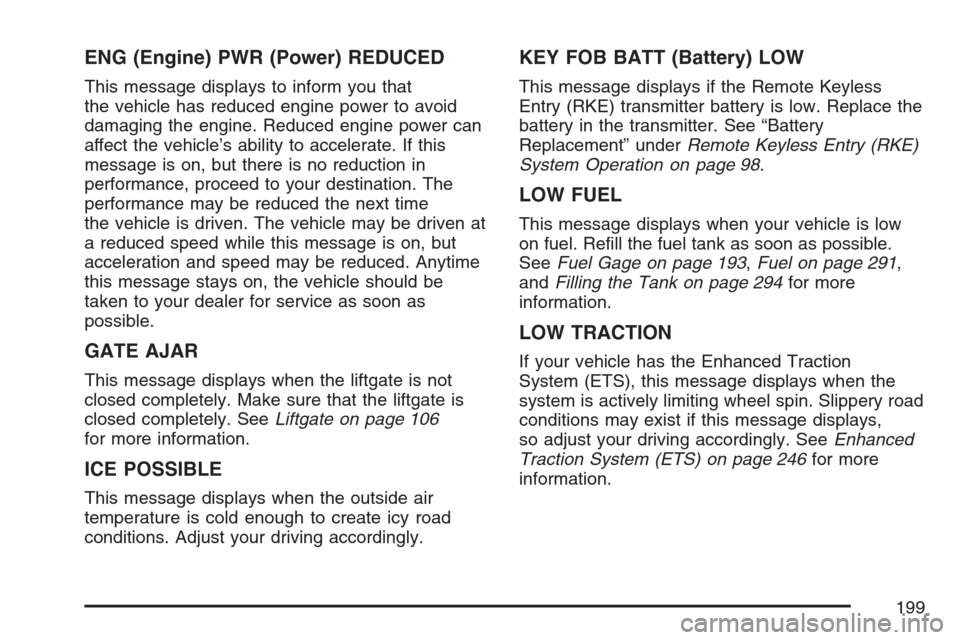
ENG (Engine) PWR (Power) REDUCED
This message displays to inform you that
the vehicle has reduced engine power to avoid
damaging the engine. Reduced engine power can
affect the vehicle’s ability to accelerate. If this
message is on, but there is no reduction in
performance, proceed to your destination. The
performance may be reduced the next time
the vehicle is driven. The vehicle may be driven at
a reduced speed while this message is on, but
acceleration and speed may be reduced. Anytime
this message stays on, the vehicle should be
taken to your dealer for service as soon as
possible.
GATE AJAR
This message displays when the liftgate is not
closed completely. Make sure that the liftgate is
closed completely. SeeLiftgate on page 106
for more information.
ICE POSSIBLE
This message displays when the outside air
temperature is cold enough to create icy road
conditions. Adjust your driving accordingly.
KEY FOB BATT (Battery) LOW
This message displays if the Remote Keyless
Entry (RKE) transmitter battery is low. Replace the
battery in the transmitter. See “Battery
Replacement” underRemote Keyless Entry (RKE)
System Operation on page 98.
LOW FUEL
This message displays when your vehicle is low
on fuel. Re�ll the fuel tank as soon as possible.
SeeFuel Gage on page 193,Fuel on page 291,
andFilling the Tank on page 294for more
information.
LOW TRACTION
If your vehicle has the Enhanced Traction
System (ETS), this message displays when the
system is actively limiting wheel spin. Slippery road
conditions may exist if this message displays,
so adjust your driving accordingly. SeeEnhanced
Traction System (ETS) on page 246for more
information.
199
Page 276 of 446
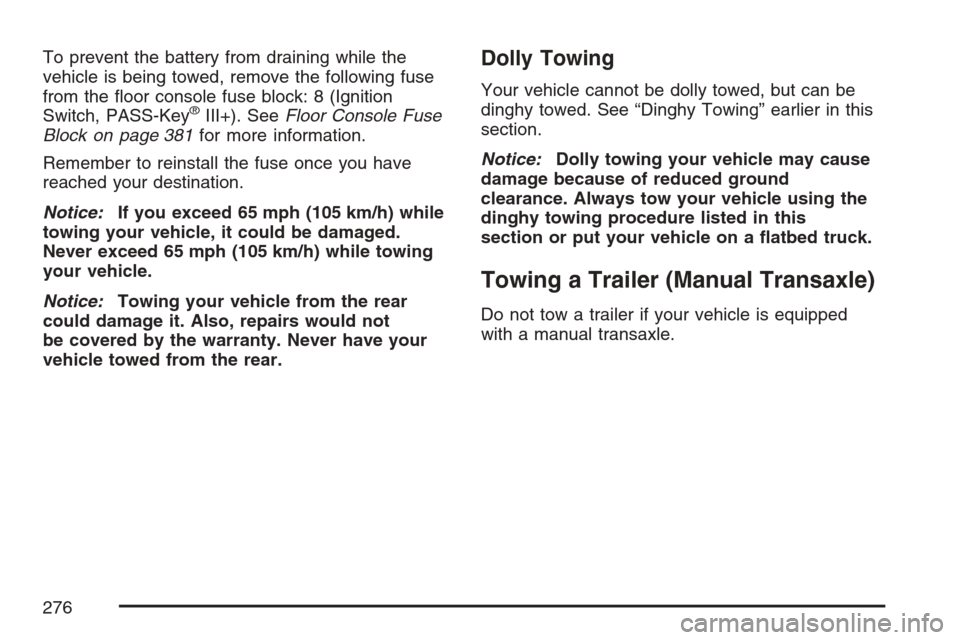
To prevent the battery from draining while the
vehicle is being towed, remove the following fuse
from the �oor console fuse block: 8 (Ignition
Switch, PASS-Key
®III+). SeeFloor Console Fuse
Block on page 381for more information.
Remember to reinstall the fuse once you have
reached your destination.
Notice:If you exceed 65 mph (105 km/h) while
towing your vehicle, it could be damaged.
Never exceed 65 mph (105 km/h) while towing
your vehicle.
Notice:Towing your vehicle from the rear
could damage it. Also, repairs would not
be covered by the warranty. Never have your
vehicle towed from the rear.
Dolly Towing
Your vehicle cannot be dolly towed, but can be
dinghy towed. See “Dinghy Towing” earlier in this
section.
Notice:Dolly towing your vehicle may cause
damage because of reduced ground
clearance. Always tow your vehicle using the
dinghy towing procedure listed in this
section or put your vehicle on a �atbed truck.
Towing a Trailer (Manual Transaxle)
Do not tow a trailer if your vehicle is equipped
with a manual transaxle.
276
Page 439 of 446
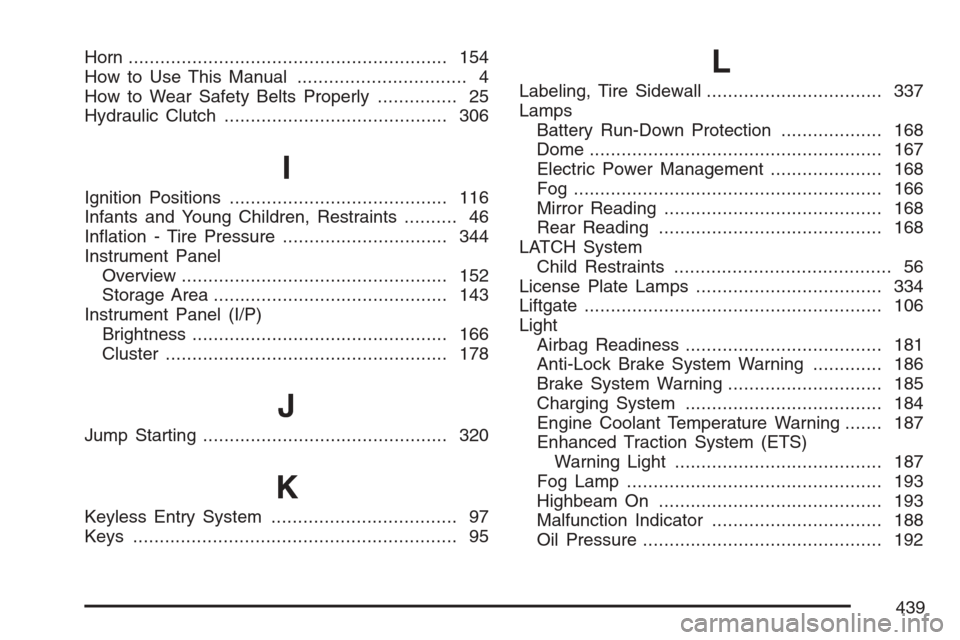
Horn............................................................ 154
How to Use This Manual................................ 4
How to Wear Safety Belts Properly............... 25
Hydraulic Clutch.......................................... 306
I
Ignition Positions......................................... 116
Infants and Young Children, Restraints.......... 46
In�ation - Tire Pressure............................... 344
Instrument Panel
Overview.................................................. 152
Storage Area............................................ 143
Instrument Panel (I/P)
Brightness................................................ 166
Cluster..................................................... 178
J
Jump Starting.............................................. 320
K
Keyless Entry System................................... 97
Keys............................................................. 95
L
Labeling, Tire Sidewall................................. 337
Lamps
Battery Run-Down Protection................... 168
Dome....................................................... 167
Electric Power Management..................... 168
Fog .......................................................... 166
Mirror Reading......................................... 168
Rear Reading.......................................... 168
LATCH System
Child Restraints......................................... 56
License Plate Lamps................................... 334
Liftgate........................................................ 106
Light
Airbag Readiness..................................... 181
Anti-Lock Brake System Warning............. 186
Brake System Warning............................. 185
Charging System..................................... 184
Engine Coolant Temperature Warning....... 187
Enhanced Traction System (ETS)
Warning Light....................................... 187
Fog Lamp................................................ 193
Highbeam On.......................................... 193
Malfunction Indicator................................ 188
Oil Pressure............................................. 192
439